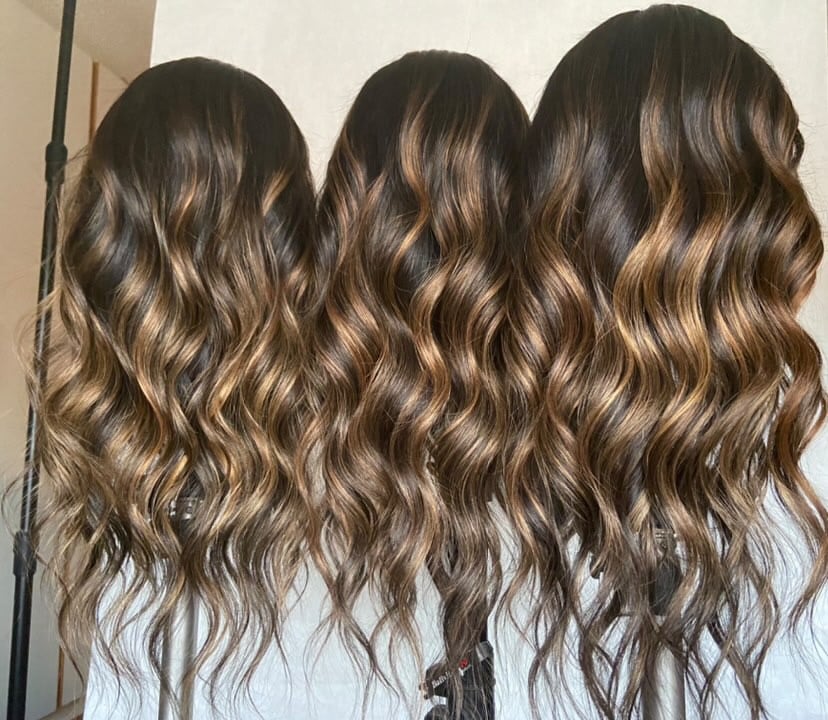
Introduction:
Because human hair wigs are more natural and adaptable than artificial wigs, they are a desired option for consumers who like a more realistic face and sense. Can real hair wigs get wet? This is a question many wig lovers have. This question includes issues regarding exposure to rain, swimming, and washing. Understanding the effects of water on human hair wigs is critical for ensuring their quality and lifespan. This post discusses the consequences of wetting human hair wigs, correct care practices, and practical wig maintenance advice.
The Nature of Human Hair Wigs

Structure and Composition
Wigs made from authentic human hair are sourced from various locations globally, where the hair is collected and treated to produce a realistic and natural-looking wig. Human hair consists of three layers. The first one is the cuticle which is the outermost layer that offers both protection and shine. The second is the cortex which determines the strength, color, and texture of the hair, whereas the last one is the medulla/bas which is the deepest component and is occasionally absent in fine hair.
Human Hair Wig Types
Several types of human hair wigs vary in quality and source:
● Virgin hair: Virgin hair has not been chemically treated to preserve its original quality.
● Remy’s hair: Cuticles are adjusted, lessening tangling without sacrificing the original appearance.
● Non-Remy Hair: Hair with misaligned cuticles, which frequently causes tangling and requires additional upkeep.
General Impact of Water
Wigs made of human hair can become wet much like genuine hair. However, water’s impact on these wigs is influenced by various factors such as the wig’s quality, the source of water used, and the subsequent drying and maintenance methods employed. Here’s a thorough analysis of these aspects:
1. Rainwater:
– Impact: When exposed briefly, rainwater is largely harmless to human hair wigs. However, soaking the wig might damage its style, causing it to become floppy and knotted.
– Care: After being exposed to rain, lightly rub the wig with a towel to eliminate extra moisture. Avoid rubbing since it might develop tangles. Let the wig air dry on a wig stand to maintain its shape.
2. Swimming Pools:
– Impact: Swimming in chlorinated pools can harm human hair wigs. it can strip away the hair’s natural luster, resulting in dry, frizzy, and potentially harmed strands.
– Care: Remember to protect your wig while swimming with a swim head cover and, make sure to clean and moisturize your wig with a hair care product made for human hair wigs.
3. Seawater:
– Impact: Like chlorine, saltwater can dry out human hair wigs. It might make your hair dry and put it at risk of breaking.
– Care: Just like in a swimming pool, using a swim helmet can help preserve the wig. Use moisturizing lotions and rinse the wig with fresh water during drying.
4. Washing:
– Impact: Wig maintenance requires washing, but it must be done carefully to prevent damage to the wig cap and hair.
– Care: Ensure to use of gentle cleaning solutions and water specifically formulated for human hair wigs. After that, gently pat the wig with a towel to remove any extra water, and then let it air dry on a wig stand.

Guidelines for Maintaining Wet Human Hair Wigs
Washing and Conditioning
Preparation:
Make sure to use a wig clean or clip to gently untangle your wig before cleaning it. This will help prevent losing hair. Get a bowl of lukewarm water and mix in a small quantity of hair care product that is free from chemicals. This will help you create a mild and gentle hair care solution.
2. Washing:
After dipping the wig into the water, carefully flip it. Refrain from washing your hat or hair. Focus on cleaning the cap because that’s where dirt and oil accumulate. Gently massage the conditioner into the cap with your fingertips.
3. Rinsing:
Rinse the wig well in slightly warm water to ensure all shampoo residue is gone.
4. Conditioning:
Always protect the roots and use a conditioning product made for human hair wigs to keep the tangles from unravelling. After a few seconds, let the conditioner remain, and then give it a good rinse with cold water.
5. Drying:
Lightly drain out the extra water. Avoid pulling or drying the wig. Use a damp cloth to remove any water from the wig. Place the wig on a wig stand to air dry, ensuring it keeps its form.
Styling After Wetting
1. Detangling:
To untangle the hair on a wig, use a wide-tooth comb once it has mostly dried. Begin with the ends and work your way upward to the roots.
2. Heat Styling:
To prevent damage to human hair wigs, apply a heat protectant spray while styling with heat equipment. Set the heat tools to a low temperature. High temperatures can destroy hair cells.
3. Natural Styling:
After letting the wig air dry for a while, use a low-speed blow dryer to finish drying for a more natural-looking finish. If you like waves or crests, use rollers or curlers and let them set until the wig dries out.
Practical Tips for Maintaining Human Hair Wigs
- Regular Maintenance:
A human hair wig’s lifetime may be extended with consistent washing, conditioning, and storing. To avoid the wig seeming drab and heavy on the hair, keep it clean and clear of product buildup.2. Storage:
Store the wig on an artificial head or wig stand to keep it in form. To shield it from dust and abrasion, wrap it with a scarf made of silk or satin.

3. Avoiding Damage:
Avoid prolonged exposure to hostile environments such as seawater, chlorine, and direct sunlight. These have the potential to impair hair quality. As alcohol, phosphates, and esters can dry your hair, choose mild products instead of ones with these ingredients.
4. Professional Care:
Consider working with a professional stylist if you don’t think you can wash and style the wig on your own. Maintaining the wig in top condition may be achieved with routine expert care.
Conclusion
In the end, while it is true that human hair wigs can become wet, how they are treated while damp has a big impact on how long they last and look. The right methods must be used to make sure the wig stays in good condition, regardless of whether it is exposed to rain, or swimming pool water or has to be washed. Maintaining human hair wigs requires understanding the effects of water, using the right treatments, and adhering to the right drying and style techniques. Wig users may prolong their wigs’ natural beauty and adaptability by following these suggestions.


